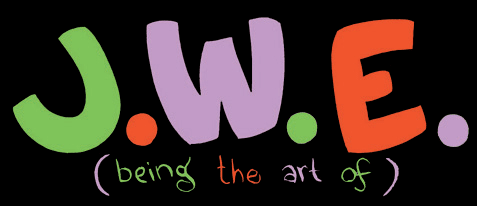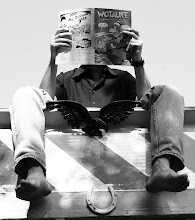Having opted to forgo using Land’s imaginary articulations in the show, I’d like to present them now, along with the works themselves, in the hope they might prove amusing.
The nine new Jumbles are currently available for purchase at Comic Art Collective.
Little Lotta & Galactus
Entitled “That Girl Eats Too Much!”, this starring piece in the show is a keen counter-dressing of two seemingly wholly disparate characters of comic book lore. Little Lotta, the over-sized, voracious eater of Harvey Comics fame, fits snuggly into the armored tunic, skirt, and headpiece of Jack Kirby’s interstellar giant, Galactus, the god-like world-eater. Here, the endlessly-hungry child is literally offered the earth and the moon, upon which she is blissfully feasting, striding the vastness of space. The obsessive appetite of each character serves as a conceptual linchpin, giving the playful tone of the Harvey milieu equal gravitas to that of Kirby’s mythic earnestness and operatic grandeur. Interestingly, Galactus feeds himself in order to literally survive an astronomically-demanding metabolism, while Lotta eats to empower herself with the massive caloric intake necessary to give herself super-strength. The starving god and the adrenalin addict, two forces destined to meet at the Dionysian dinner table. – A.L.
Fred Flintstone & Alley Oop
Here we have “Laughable Origins”, another combination in which the jumble effect has coalesced into something approximating union, but this time it is the corporal form that has more readily merged, the clothing remaining in a stubborn state of apparent disapproval. Exploring the similar, yet oppositional form of these two essentially brutish prehistoric characters, Hanna-Barbera’s Fred Flintstone and V.T. Hamlin’s Alley Oop, we find Flintstone’s three-toed foot seeming like a broken parody of Oop’s more authentically-muscled appendage. The image appears to comment upon their primitive iconography, one being the Jackie Gleason-based everyman with the large, almost over-bearing eyes, the other a more competent model of patriarchy sporting a mere pinpoint optic, made expressive only by an extensive, pencil-thin eyebrow. Their composite creation seems to be making the case for man’s binary evolution, that of the progress of his physical aptitude, along with his simultaneous mental/emotional digressions. An eminently bi-polar ancestor, if there ever was one. – A.L.
Bullwinkle & Mark Trail
Calling this piece “Animal Husbands” is clearly suggesting there is something more than a professional interest between park ranger, Mark Trail, star of the long-running newspaper strip created by Ed Dodd and Jack Elrod, and moose, Bullwinkle, star of the revered The Bullwinkle Show, created by Jay Ward and Alex Anderson. The intimate coupling pictured is both homoerotic, hands holding nuts, placed near to groin, and embryogenic, Trail appearing within the womb-like frame of arms, and the unquestionably phallic snout of Bullwinkle (to say nothing of his orgiastic countenance). The white-gloved finger of the moose, positioned for insertion before his extended nostril, is only further indication of the inherent sexual energy of the piece. It is interesting to note the tryst is taking place in the fall (the brown leaves spelling this out) and not the spring, the traditional season of such physical attraction. Am I going out on a limb to suggest the artist is none-too-subtly criticizing the alternative lifestyle, indicating it being the path to a “fall” from grace? Or is this just me over-thinking? The particulars do look quite happy, after all. – A.L.
Betty Boop & Andy Capp
Entitled "An Adult Conversation", this semi-abstract image portrays the inebriated tumult of limb and leer that is the inevitable outcome of a meeting between two iconic cartoon archetypes of yesteryear, Betty Boop and Andy Capp, the floozy and the barfly of the comics page, created by Grim Natwick and Reg Smythe, respectively. Focusing on the thinly-veiled carnality of each character, the artist seems intent on assembling the Freudian aspects of their trademark anatomies, in such a fashion as to playfully hint at these adult considerations, which have, over the years, been denuded and all but erased from their respective mythologies. Here we have Capp’s scarf, protruding erect and red from Boop’s thigh, while Boop grasps Capp’s penis-like foot, her golden necklace vaginal about her wrist, Capp’s other leg positioned for fornication, his thumb rising in approval towards Boop’s garter, as Boop herself seems to be considering Capp’s all-too-phallic, pink-tinged nose, the iconic part in her hair a invitation to further penetration. As all of this implied sexual activity proceeds, Capp’s beer sports an overflowing head, Boop’s martini a cherry, Capp’s cigarette end rising in apparent excitement, watched with interest by Boop’s satellite eye, its heavy lashes pubic in form. A Bacchanalian display of the potent libido which sits at the wellspring of most true pulp concerns, if I’ve ever seen one. – A.L.
Mr. Magoo & Daredevil
Here we have “The Club and Cane Club”, an obvious commentary upon the sightless and sight-impaired in our society. Featuring the visually myopic Mr. Magoo, the bumbling geriatric bachelor of many a popular animated short, created by the UPA Animation Studio, and Daredevil, Marvel Comics’ blind superhero, created by Stan Lee and Bill Everett , this radar-like twirl of head, hand, leg, walking stick, and chapeau is all-too-evidently concerned with the stigma of visual handicap, not just focusing on the perspective of the seeing population, but more succinctly it appears to address the internal strife within the blind community itself, the degree of one’s condition being contested and determined. Note the disembodied hand of each character, reaching out to encounter the other’s face, evoking the trope of the stereotypical blind man reading the face of a stranger as if it were Braille. At the same time we see Daredevil’s other hand, seemingly ready to support Magoo’s wandering foot, while Magoo’s floating hat looks ready to settle upon the heroes’ overtly-Satanic cowl. Is the fully blind offering the partially blind a hand, or is the near-blind attempting to conceal the sightless man’s “otherness”? Are these, perhaps, both gestures of kindness, or are they the visual depiction of an endless argument? The contradictions abound, the least of which is the unclear relationship between Magoo’s cane and Daredevil’s billy club, one there to support, the other to defend and attack. – A.L.
The Black Panther & The Pink Panther
There can be little doubt that this work, boldly entitled “The Secret Dance of America”, is primarily, and solely, concerning itself with our nation’s state of racial disharmony. The Black Panther, the super heroic prince of the fictional African nation of Wakanda, was created by Jack Kirby in 1966, the same year that saw the formation of the identically-named civil rights organization. The Pink Panther, the DePatie-Freleng Studio creation, first appeared in the title credits of the 1963 film, The Pink Panther. Both are here juxtaposed to suggest competition and submission. The eminently European Pink Panther, all sly of movement and intent, is caught in the forward march of the Black Panther, who is focused on a clawing struggle to liberate himself from the bodily barriers the Pink Panther offers up, even as the Pink Panther himself is clearly being deconstructed. There is an almost thankful, relieved look on the Pink Panther’s face, as the Black Panther’s arm separates him from the rest of his body. Can the artist be suggesting that there is a freedom to be found for both, in the ultimate liberation of The Black Panther? Or is he portraying the divisive and cutting nature of the relationship, the co-mingling of two races bound by a history of commercial abduction, displacement, murder, and slavery? – A.L
Casper & Deadman
The title of this piece, “Father Knows Best”, is evidence of a deep paternal longing, one mired in the confusing trails of generation, and its biological inheritance. Here we find the apprehensive countenance of Casper the Friendly Ghost, Harvey Comics’ curious approximation of infant mortality, as he finds himself wrapped within the shroud of Deadman, the DC Comics supernatural hero, a literal dead man who inhabits the bodies of the living to carry out his will. The nighttime scene, the lonely-looking cemetery, and the fresh dirt clinging to the hands and feet of the characters, all point to a recent resurrection, the eerily-composed specter of father and son (be they inherited or related through their proximity to death) having exhumed itself from the grave. From the nervous look on Casper’s face, we can only presume that the will of the father, the Deadman, is the force piloting this nocturnal zombie sojourn. Even in death, the son must obey, his very limbs now crudely wrapped into a bundle with those of his father, secured by Deadman’s blood-red cummerbund, the stoic letter “D” teetering above his head, its pointed serifs threatening reminders of who is in charge, the curse of biological inevitability. – A.L.
Ant-Man & Atom Ant
The title of this piece, “A Colony for the Taking”, would seem to imply some form of colonialism is taking place, though by whom, and to whom, is open to conjecture. We first notice the scattered essentials of the two protagonists of the illustrated tableau, Marvel Comics’ Ant-Man, created by Stan Lee and Jack Kirby, and Atom Ant, the entomologically-inclined super hero created by Hanna-Barbera Studios. These body parts appear like crumbs upon a picnic blanket, readily attended to by numerous black ants. That one character is able to communicate with ants, while the other is an ant himself, offers a bounty of psychological entreaties as to the nature of their relationship. Atom Ant is clearly grinning up at Ant-Man’s inverted head, his antennae are prostrate, though curled at the ends, perhaps indicating a willingness to converse, but coming with certain requirements and safeguards. Ant-Man, on the other hand, has resolutely pronged antennae, but his expression betrays a very real anticipation of need for concern. True to their respective duties and folkloric traditions, each appears ready to counter any affront, strapped into their white helmets like race car drivers, Atom Ant’s torso pointing the way towards impending action, its handless arm interestingly accompanied by Ant-Man’s much larger, complete one. – A.L.
Thor & Asterix
The mythology of mythology itself is tackled in this intriguing cornucopia of metal and primary fabric, a tight, formulated grouping of two of comicdom’s most popular ancient warriors, Marvel Comics’ The Mighty Thor, created by Jack Kirby, and Asterix, the super-empowered ancient Gaul, one of France’s most enduring comic characters, created by Rene Goscinny and Albert Uderzo. In this piece, amusingly entitled “An Old Grudge”, many historical implications arise, along with provincial considerations, Thor’s Norse, Germanic Pagan origin perhaps complimenting that of the pint-sized, but spirited Gaul, devoted enemy of the Romans. The visual echoes are many, further uniting the boisterous couple. Each dons a winged, metal helmet, has flowing, golden hair and dark eyebrows. Asterix’s belt is decorated with ovals, as is Thor’s tunic, each wears yellow boots, each is sleeveless and gloveless. The permeation of yellow acts as a thread of unity, a shared battle hue and cry, if you will, one that points to a singular Germanic association, if not a mirrored birthright. Hammer of lightning meets blade powered by pagan elixir, myth and alchemy colliding in a bright, frantic tapestry spun of the warring spirit. – A.L.
ANDREW LAND, born in 1956, in Cambridge, England, is a preeminent commentator upon today’s varied artistic disciplines, a critic who brings a wealth of historical and cultural knowledge to his criticism and other writings. A man known to tackle the merit of neo-Teutonic bead art and manic-depressive finger painting with equal aplomb, he is also the proud parent of an award-winning Corgi named Smooches.













